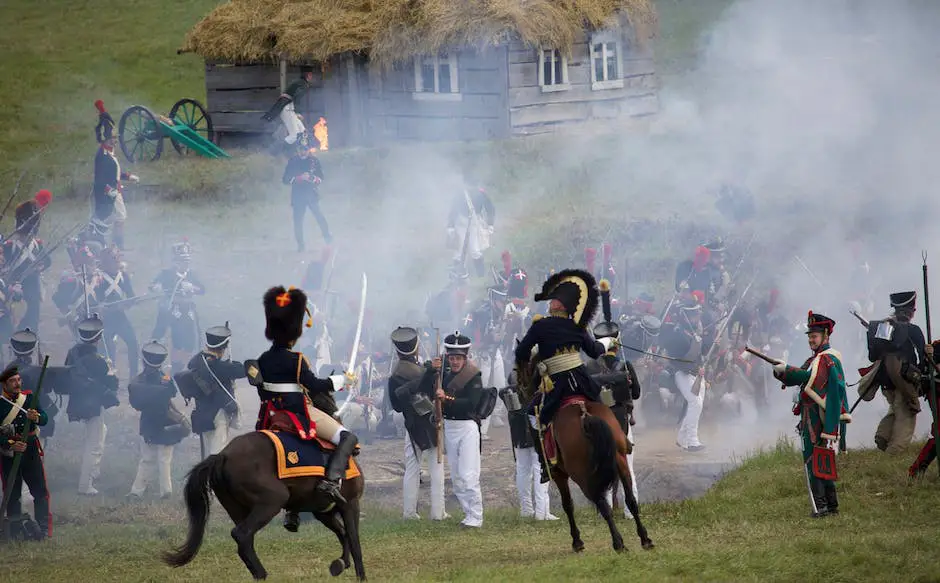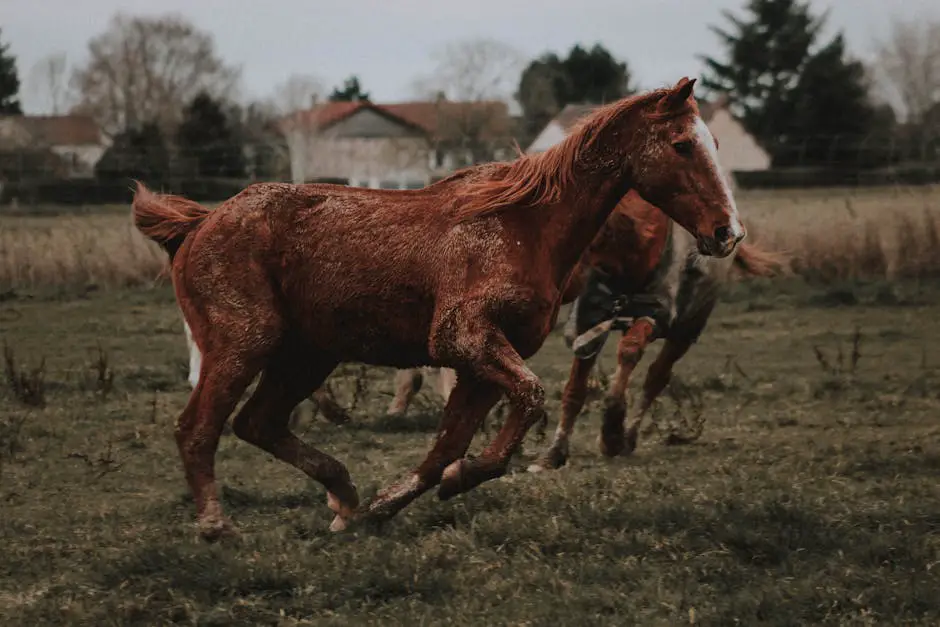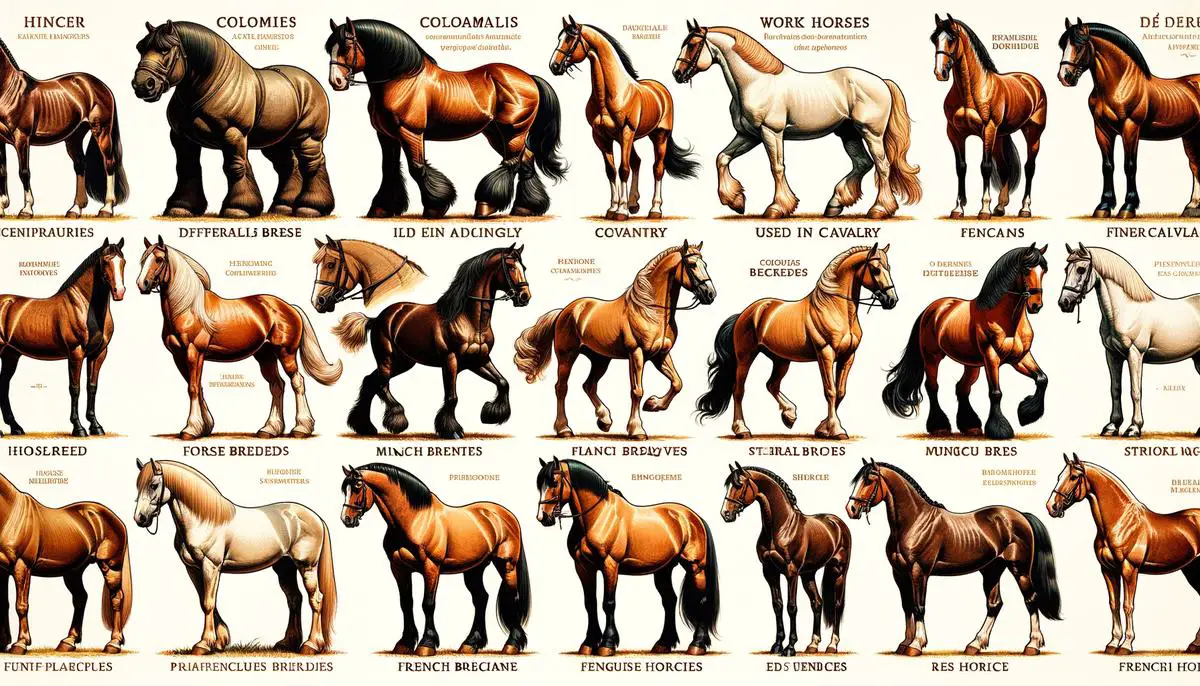The story of French horse breeds is a fascinating and integral part of the nation’s heritage, weaving through the fabric of history and culture. These breeds, from the strong Percheron to the agile French Trotter, have not just shaped the agricultural and economic landscapes but have also played a significant role in the cultural identity of France and its global influence. This article aims to explore the multifaceted roles these horses have played and continue to play, underlining their importance in past, present, and future contexts without getting lost in the specifics too early.
Table of Contents (Horspedia)
The History of French Horse Breeds
The influence of French horse breeds on history and culture is a tale as rich and complex as France itself. From the powerful Percheron to the elegant French Trotter, these breeds have not only affected agricultural and economic development but also left an indelible mark on cultural norms and artistic expression throughout France and beyond.
The Percheron, characterized by its strength and endurance, emerged in the Perche province of France. This breed, known for its considerable size and versatility, became indispensable in medieval times for transportation and agriculture, significantly contributing to France’s economic development. Beyond their utilitarian value, Percherons symbolized the nation’s resilience and work ethic, becoming a source of national pride.
Similarly, the Camargue breed, with its origins in the Rhône River delta, represents a wilder aspect of French equestrian heritage. These small, hardy horses are integral to the traditional cowherding practices in the Camargue region, showcasing a unique blend of human and animal cooperation that has been celebrated in French literature and art. The annual gathering and running of the Camargue horses is a cultural event that attracts tourists, capturing the imagination of those fascinated by the untamed spirit of these animals.
The French Trotter, developed for harness racing, tells another story of French innovation and passion for equine sports. The breed’s creation reflects France’s longstanding interest in horse racing, a sport that has influenced social norms, fashion, and even politics. The success of French Trotters on the track has not only brought glory to their breeders but also significantly impacted the rural economies tied to the racing industry.
French cavalry mounts, including breeds like the Selle Français, have a storied military history that intersects with key historical moments. The prowess of French cavalry, mounted on such versatile and capable horses, was a crucial element in numerous military campaigns. The Selle Français, in particular, demonstrates the French knack for breeding horses that excel in both sport and combat, embodying the elegance and martial spirit of the nation.
Culturally, these breeds have insinuated themselves into the fabric of French identity. Literature and art abound with references to the horse’s role in French history, from the chivalric tales of knights and their mighty Percherons to the pastoral paintings of Camargue horses against the backdrop of the marshes. This cultural legacy continues to influence contemporary perceptions of France, both domestically and internationally.
In the realm of sports, France’s equestrian tradition has fostered a deep appreciation for horse riding as both an art form and a competitive endeavor. This tradition is celebrated annually at events like the Paris Horse Show, drawing participants and spectators from around the globe, further solidifying the importance of horse breeds in shaping French culture and identity.
Through their contributions to agriculture, economy, military, sports, and culture, French horse breeds have played a pivotal role in shaping the narrative of France’s past and present. Each breed, with its unique characteristics and history, highlights different aspects of French life and tradition, weaving a rich tapestry that continues to captivate and influence those within and beyond France’s borders.

Characteristics of Key French Horse Breeds
When exploring the landscape of French horse breeds, it’s crucial to acknowledge not just their storied histories and contributions but also the unique characteristics that distinguish these breeds from one another. Each breed carries its distinct set of traits, purposes, and places in France’s agricultural and cultural tapestry.
Starting with the Breton, this breed stands out for its robust physique and versatility. Originally from Brittany, the Breton is often seen in shades of chestnut and bay and is primarily used for draft and farm work due to its tremendous strength. Beyond its physical prowess, the Breton is known for its docile temperament, making it a reliable workhorse and a favored breed for agricultural tasks. Its impact on the farming practices in Brittany and across France cannot be overstated, contributing significantly to the efficiency of French agriculture.
Contrastingly, the Normandy Cob, hailing from the Normandy region, serves a slightly different purpose. This breed is particularly recognized for its carriage driving and riding qualities besides being used for light draft and farm work. With a more refined build than the Breton, the Normandy Cob combines strength with elegance, showcasing versatility in sports and ceremonial roles. This breed’s adaptability has made it a prominent figure in both rural and urban settings, symbolizing the harmony between tradition and modernity in French equestrianism.
Another notable breed is the French Anglo-Arab, a product of crossing Arabian and Thoroughbred horses with local French stock. Renowned for its endurance, speed, and agility, the French Anglo-Arab excels in eventing and endurance racing. This breed’s influence extends beyond competitive sports; it has also contributed to the refinement of other French horse breeds. The elegant appearance, combined with spirited yet manageable temperament, makes the French Anglo-Arab an emblem of grace and performance in the French horse breeding tradition.
Distinguishing these major French horse breeds from each other involves recognizing their intended uses, physical characteristics, and historical roles within France. The Breton’s draft capabilities, the Normandy Cob’s versatility, and the French Anglo-Arab’s speed and endurance highlight the variety and specialization within French equestrian heritage. Each breed, with its distinct features, contributes to the rich tapestry of France’s agricultural, sporting, and cultural narratives, underscoring the country’s deep connection to its equestrian roots.

Conservation and Preservation Efforts
Despite the rich history and cultural significance, French horse breeds face a slew of modern challenges. At the heart of these issues is a juggling act between preserving traditional practices and adapting to contemporary demands. The heritage breeds, including the resilient Breton, the versatile Normandy Cob, and the swift French Anglo-Arab, aren’t just facing one challenge but a multifaceted array of issues that span economic, environmental, and societal realms.
A critical point of contention is the looming shadow of industrialization and mechanization. As France, like much of the world, leans heavily into more efficient, mechanical means for agriculture and transport, the roles traditionally filled by breeds like the Breton and Normandy Cob are diminishing. This shift not only affects the practical demand for these horses but also impacts the rural economies that once thrived on the breeding and selling of such animals. For many communities, these breeds weren’t just animals; they were a way of life and a source of livelihood.
Furthermore, the increasing urbanization of France poses another significant challenge. As more land is earmarked for development, the natural habitats and grazing lands crucial for maintaining healthy horse populations are under threat. This loss of space doesn’t just impact the physical well-being of the horses but also restricts the ability of breeders to maintain large, genetically diverse populations. Reduced genetic diversity can lead to a host of issues, including increased susceptibility to disease and inbreeding depression, endangering the long-term viability of these breeds.
Environmental concerns also cast a long shadow. Climate change, with its associated weather extremities such as droughts and floods, directly impacts the delicate balance of ecosystems that these horses and their breeding programs rely on. For example, the Camargue region, known for its free-roaming horses, is particularly vulnerable to rising sea levels and increased salinity, which could decimate the grasslands these horses depend on.
On a societal level, the diminishing role of these animals in daily French life affects public awareness and appreciation of these breeds. With fewer people directly interacting with these horses, there’s a risk that the cultural heritage and historical significance they represent could fade from collective memory. This lack of awareness poses a challenge for conservation efforts, as public support is often crucial for funding programs aimed at preserving heritage breeds.
Moreover, the specialty and niche uses of French horse breeds, such as in competitive sports (eventing, endurance racing, etc.) offered by the likes of the French Anglo-Arab, present both an opportunity and a hurdle. While these activities can showcase the breeds’ superior attributes and garner interest, they also require significant investment in training and facilities. The economic burden of such endeavors can be prohibitive for smaller breeders, potentially leading to a concentration of these breeds among wealthier enthusiasts and a move away from traditional breeding practices.
In the context of these challenges, the future of French horse breeds seems to rest on a knife-edge. Balancing the preservation of cultural heritage with the realities of modernization and environmental conservation requires innovative approaches. Perhaps more than ever, there is a need for a cohesive strategy that involves governments, local communities, and international conservation bodies working together to ensure these living symbols of French heritage continue to grace the countryside and competition fields. Solutions may include breeding programs that emphasize genetic diversity, sustainable agriculture practices that integrate traditional horse roles, and educational campaigns to raise awareness about the value and contribution of these breeds to French culture and history.

The Cultural Significance of French Horse Breeds in Modern Times
Breton Horse: An Agricultural Powerhouse
Diving into the heart of French agricultural evolution, the Breton horse emerges as a significant player. Known for its remarkable strength and robust build, this breed has been indispensable in transforming and maintaining French farmlands. Beyond its physical prowess, the Breton horse boasts a docile nature, making it a reliable partner in the demanding tasks of plowing and hauling.
The versatility of the Breton is notable. It adapts seamlessly from fieldwork to carrying heavy loads, demonstrating an unparalleled work ethic. This breed’s contribution extends beyond merely agricultural; its presence is a testament to the enduring relationship between horses and humans in rural France, shaping the landscape and the culture surrounding French agronomy.
Normandy Cob: A Symbol of Elegance and Power
Transitioning from the fields to the picturesque lanes of France, the Normandy Cob represents a blend of strength and grace. Historically favored for both light draft work and riding, its influence stretches into the aesthetic realm of carriage driving. The Cob’s elegant strides and carriage presence highlight a deep-rooted appreciation for equine beauty and functionality in French tradition.
Their adaptability is evident as they serve dual roles in both rural and urban settings, symbolizing a bridge between traditional agricultural life and the nostalgic charm of city celebrations and parades. As emblems of versatility, Normandy Cobs enrich the tapestry of France’s equestrian lineage, encompassing both work and pleasure in their stride.
French Anglo-Arab: The Epitome of Endurance and Refinement
At the intersection of speed, agility, and stamina, the French Anglo-Arab horse charts a unique course. This breed flourishes in the demanding disciplines of eventing and endurance racing, showcasing the harmonious blend achieved from merging Arabian, Thoroughbred, and local French stock. The French Anglo-Arab stands as a pinnacle of equestrian excellence — a product of strategic breeding that highlights the French approach to enhancing equine capabilities.
Their influence extends beyond the racetrack or eventing course, contributing significantly to the refinement of other French horse breeds. This exchange of genetic virtues has bolstered the overall quality and versatility of France’s equine population, cementing the Anglo-Arab’s role in the broader narrative of French equestrian heritage.
Facing Modern Challenges: The Path Ahead for French Horse Breeds
Despite their storied histories and contributions, French horse breeds face modern adversities that threaten their continuation and relevance. Industrialization and urbanization have dramatically altered the landscape, leading to a diminished role for these animals in a mechanized world. The issue of maintaining genetic diversity becomes paramount in ensuring the health and viability of these breeds for future generations.
Furthermore, climate change introduces new challenges to their ecosystems, requiring adaptive strategies to safeguard their existence. A dwindling public interest in these historical breeds places additional pressure on the communities and enthusiasts dedicated to their preservation.
As we navigate these complexities, the call for a cohesive, multi-faceted approach to conservation is clear. Stakeholders, including governments, breeders, and environmental groups, must collaborate to devise sustainable solutions. Breeding programs, awareness campaigns, and integration into sustainable agricultural practices present viable pathways to rekindle public interest and support for these emblematic facets of French heritage.
Through such efforts, the enduring legacy of French horse breeds can continue to enchant and serve, echoing the depth of France’s equestrian roots into the future.

The legacy of French horse breeds extends far beyond their historical contributions, embodying a living connection to France’s cultural and agrarian traditions. Amidst modern challenges, these equine treasures stand as a testament to resilience, versatility, and enduring beauty. By ensuring their preservation, we honor not only the rich tapestry of French history but also safeguard a vital part of the nation’s living heritage for future generations. The continued fascination and dedication to these breeds highlight their unbreakable bond with human society, promising that their influence will resonate for years to come.
